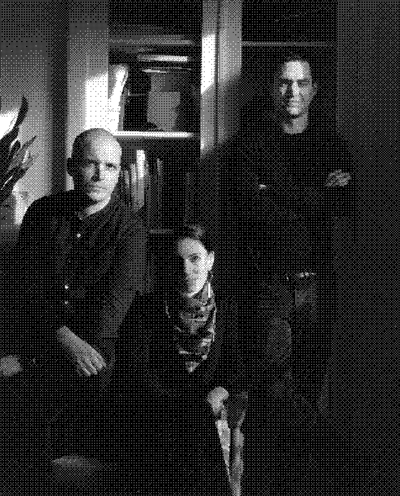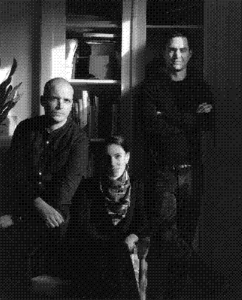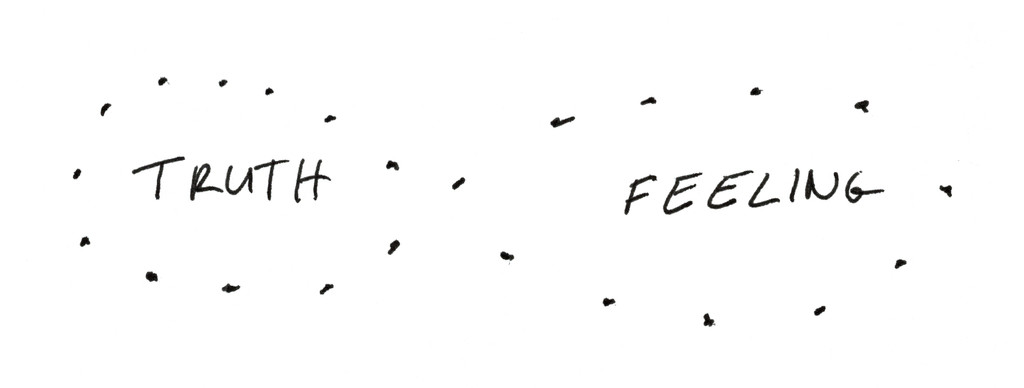Could you please introduce yourselves?
My name is Maik Bluhm. I’m a partner at CATK.
SG
And I’m Sebastian Gerbert, also a partner at CATK.
MB AND SG
We’re both here for the interview, but there are actually four partners at CATK. The studio was co-founded by us and Elisabeth, and later Ines joined, so today the four of us run CATK together. We share a deep connection and continue to be very good friends, which helps keep things moving in the right direction.
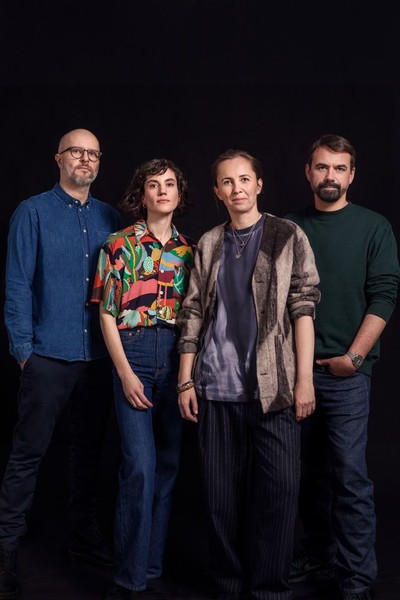
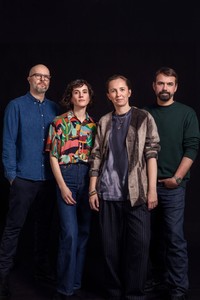
From left to right: Sebastian Gerbert, Ines Graf, Elisabeth Schulze, Maik Bluhm – Partners at CATK
How do you currently present CATK?
We present it as a family business. That’s always the core: working with good people. That’s open to interpretation, but it’s really important for us to hire people that we get along with on a personal level and that somehow have the same ethos and moral compass. That is also how we like to present the studio, that the work is connected to the people, and thus gives you an experience that goes beyond the design, but is also a worldview.
SG
We would say we are a multidisciplinary design studio focusing on solving problems.
What’s your current state of mind today, beginning of spring 2025?
Winter’s over. It’s becoming spring, so the mood is getting better. In general, looking at the political situation, I’m a bit frightened, but I have a positive outlook on the future. I hope we can steer the ship in the right direction.
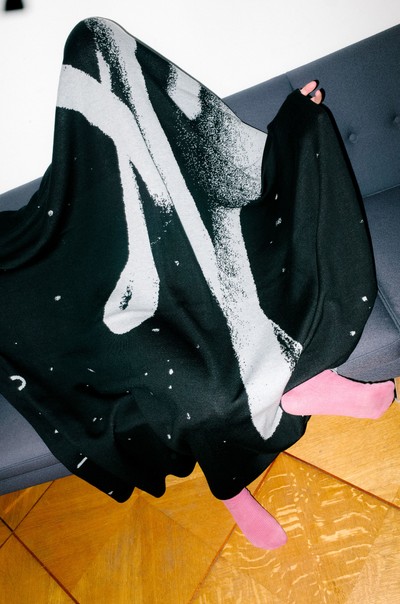
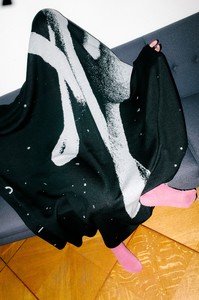
Goods by Work by Colors And The Kids
If we go back to your career and the creative side of it, could you tell us what got you into design? Graphic design? Art direction?
You have to go back to when I was a kid. I always loved art classes and also built stuff. For me, it was like a merger of doing creative stuff and technology. Because the first computers were coming out, and I remember discovering Photoshop for the first time, in a super early version, and being able to manipulate photographs. I think that triggered something, I thought it was really, really interesting what you could do with digital processing.
SG
For me, it’s kind of the same. I guess you could say we had the same interests, even though we didn’t know each other at the time. But I was also more interested in technology and computers. Then I got into image-making, and in 1992, I remember watching Terminator 2 by James Cameron. The whole visual world just intrigued me, and I became super interested in how to create those images. That led me to film, film titles, and movies, which eventually brought me into 3D animation and studying media art. That’s the gist of it—in compressed form.
What did you do before founding CATK?
I worked at a small agency right after school, before starting my studies. When I began university, I did not just meet Sebastian, I also started working for a music label, doing all design related things for them. During my studies, I spent a year and a half in Italy and was lucky to receive a stipend to work as a researcher at Fabrica, a creative center founded by Oliviero Toscani and Luciano Benetton.
SG
We knew each other from university. We lived together. We were already working together, making visuals for music. Maik was designing record covers for a band, and then we somehow rejoined, working on music, videos, visuals, and all that stuff. That’s where it all developed from.
So you founded CATK right after your studies?
We did a bit of freelancing because we needed money. Our funds were depleted after our studies, but about a year later, we founded CATK.
What were you thinking at the time? What did you imagine CATK would become?
When we met in university and worked on our first project together, we had this idea that it needed to be flashy, innovative, something people would want to look at. And I think we kept that ethos for CATK. In the beginning, we were just reworking portfolio pieces, creating things we wanted to do, and that eventually got us our first projects.
Did you have any vision for what CATK could become, or was it more of a “let’s do what we want and see where it goes” approach?
For me, it was always about global relevance. I was inspired by global studios and wanted CATK to play a role on that level. I didn’t want to become just another local design studio doing nice work for neighborhood cafés. Even though I appreciate that kind of work, I wanted our peer group to be broader, more international.
SG
We were looking at other studios. For me, one of the biggest influences was Designers Republic. They were right here while we were just starting out, and we always wondered how did they get there? What are we doing to reach that level? Over time, that curiosity kept driving us. We were constantly experimenting, developing ideas, and creating just for the sake of it. We didn’t have clients at the beginning, so we simply made things, tested ideas, and shared them. We pushed further into 3D, tried crazier things, and it just naturally evolved from there.
Since then, have there been any surprises? Positive or negative?
I think we grew too slowly at one point. There was more demand than we could handle, so we had to let go of some projects. That was definitely a challenge. Then, on a personal level, we had kids, and that slowed down the process even more. We couldn’t expand as much as we might have otherwise. That brought some difficulties, but overall, I’m quite happy with how things turned out.
You mentioned Designers Republic, which is a great reference. When you were finishing your studies and freelancing, what were your other creative influences?
It was always art for me. Of course, there were design influences, Designers Republic, Why Not Associates, David Carson, Dieter Rams. The basics, the good stuff. But what really intrigued me was going to art exhibitions. Design is functional, and I love that, but exhibitions opened up new worlds. Some pieces exist simply because the artist wanted them to exist, not for function, just because they had to be made. You can feel that freedom in the work, and that’s always been inspiring to me.
SG
That mix between art and design was always present for us. In the beginning, we struggled with it, art was one thing, design was another, and they didn’t seem to belong together. Now, though, I feel like those boundaries have blurred. They coexist in a much more natural way. Our personal creative practices and our studio work always influenced each other. I think that’s a big reason why our studio is the way it is today.
After 17 years of doing this, how has your personal creativity evolved? How do you work now compared to before?
I’ve learned to trust my intuition, and that has become a real strength. One of the benefits of getting older is gaining a clearer sense of who you are and what you want. That self-awareness makes a huge difference, not just in making creative decisions but also in guiding the team. It helps me articulate why something works or doesn’t, giving constructive feedback while also staying open to new ideas. I think the ability to listen is as important as having strong instincts.


Work by Colors And The Kids - Attinia
You also mentioned working with a team, especially younger members. Does that help keep the creative energy alive at CATK?
Since we all come from an art background, creativity has always been central to what we do. We make a point of bringing in younger team members who share that same curiosity and passion for the world around them. Over time, we’ve built a group of like-minded people who, even if we have different tastes, can communicate easily about creative solutions. Sometimes, I walk around the studio, see what someone is working on, and think, “Wow, I wish I had done that!” That feeling is really rewarding. It reminds me of when we first started, looking at each other’s screens, getting excited about what the other person was creating. Now, we get to experience that same dynamic with the next generation of designers. It’s a lot of fun.
MB
Beyond that, each of us still pursues its own creative projects. I think that’s crucial, it’s a way to keep something personal in the mix, even while handling the management side of things. Sometimes, when you run a studio, the business side takes over, and you can lose touch with the creative process. Having our own creative outlets keeps us grounded and inspired.
So you’re saying you’re still hands-on, still designing alongside running the business?
Exactly. And coming back to your earlier question—has creativity changed? I’d say no, and that’s the best part. Every morning, I wake up excited to create something new. That enthusiasm feeds into the studio culture, making sure what we do has purpose and remains exciting.
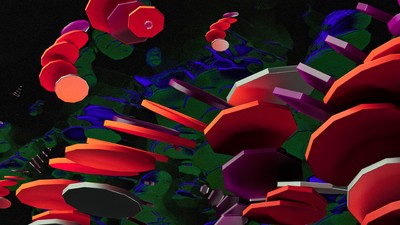
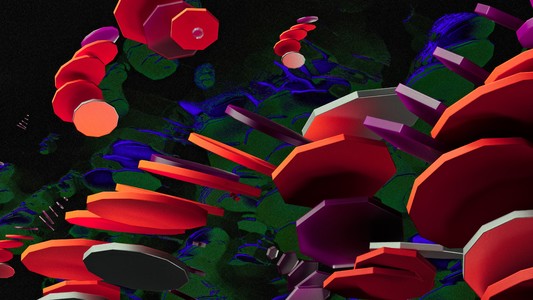
Work by Colors And The Kids - Attinia
You’ve always been deeply connected to technology, computers, digital advancements, it’s been part of your DNA from the start. Do you look for that in the people you hire?
Not necessarily. We have a mix. Our two other partners, Elisabeth and Ines, bring different perspectives, Elisabeth comes from a fine art background, and Ines is a musician. We value that diversity. Our last hire, for example, is an incredible designer, but technical perfection wasn’t the main criteria. Some people in the studio need to be highly technical, but others bring something more intuitive, more emotional. It’s important to have both.
You mentioned Ines plays an instrument. Did that influence the studio’s focus on sound design?
Absolutely. We were always experimenting with sound, but when she joined full-time, we really started refining that part of our work. A lot of sound design today is very tech-driven, and while it’s impressive, it can sometimes feel cold. Ines brings an emotional depth to it, she understands composition on a deeper level, which makes a huge difference. That balance between technical precision and emotional resonance is something we always strive for.
Earlier, we talked about creative inspirations… Did you have any strategic influences over the years?
Most of what we do is based on intuition, but we also understand the markets we’re working in and how to position ourselves. Social media, for example, we know we can’t ignore it, but we also use it strategically. Sometimes, we take on research projects that align with where we want to go, making sure we stay relevant while staying true to our creative vision.
SG
A lot of our strategy comes from intuition, but we also spend a lot of time discussing and analyzing our direction. The four of us talk through almost everything, though with how busy we are now, that’s not always possible. But we try to balance what excites us creatively with what makes sense strategically. We are very careful about how we present ourselves. It’s important to us that our message is clear and thoughtful.
MB
I think details matter. We pay a lot of attention to them, both internally and in discussions. Of course, we also look at other companies and how they approach certain things. For example, in the design world, Pentagram comes to mind, their partner-focused structure and communication style resonate with us. There’s always a partner involved in client calls, which keeps things personal. Growing up, my father ran a small steel factory, and I worked closely with the people there. That experience reinforced my belief that collaboration is key. That’s why we emphasize working at eye level, treating each other with respect, and fostering a positive environment.
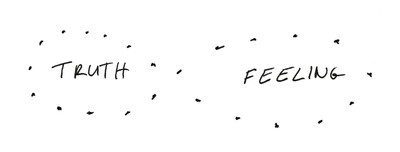
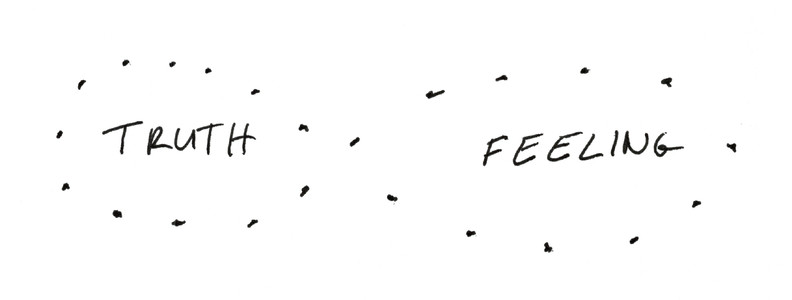
Sketch by Maik Bluhm
How do you make big decisions? I assume you all have a lot of autonomy, but when a major decision comes up, how do you regroup and decide?
Funny enough, we had a situation like that just yesterday. A job request came in, and it was a bit morally complicated. The four of us discussed it, two were a clear “no” from the start, while the other two considered it from a business standpoint. It was a strategic decision. But in the end, the “no” arguments were stronger, and we decided against it. Our decision-making process is democratic. We discuss things, sometimes maybe a bit too much, but that’s how democracy works, and I really like that.
Is there a possibility for an associate to veto a project?
Actually, we do have a sort of “mega veto”. If someone is strongly opposed to something, they can put their foot down and say, “No, this doesn’t work.”
MB
And in that case, the project simply doesn’t happen.
SG
It is very rare. I honestly can’t remember the last time it happened. We’ve known each other for such a long time, and we truly appreciate one another’s perspectives. For most decisions, I don’t want to make them alone. It’s helpful to have the group, to have someone mirror your thoughts back to you, challenge your thinking, or provide another opinion. That actually makes decision-making easier.
MB
For us, decision-making is actually quite fast because we trust each other completely. When someone drafts an email or makes a decision, we know it’s fine, we don’t need to second-guess each other. For bigger decisions, of course, we regroup, but for day-to-day operations, there’s a lot of trust. That level of trust speeds everything up.
SG
I completely agree, trust is everything. I can’t recall a single time in the past few years where I felt left out of a decision or unhappy with one. We’ve always steered the studio in the right direction. There’s never been a major clash because we’re so aligned, and that makes all the difference.
MB
One important rule we follow is that once a decision is made, we don’t go back and question it or assign blame. If we’ve all agreed on something,especially if no one used their “mega veto”, then the decision is unanimous. That makes things easier because we’re not constantly second-guessing ourselves. Of course, analyzing decisions can be valuable, but in general, once a decision is made, it’s done.
SG
It’s also about having each other’s backs. Even if someone initially had doubts or if something goes wrong, it’s still our decision. We made it together, so we stand by it and solve any issues as a team.
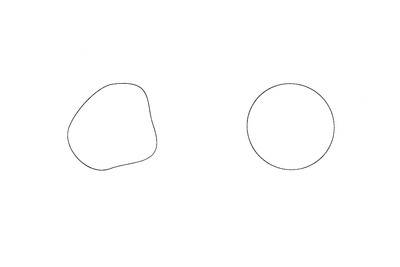
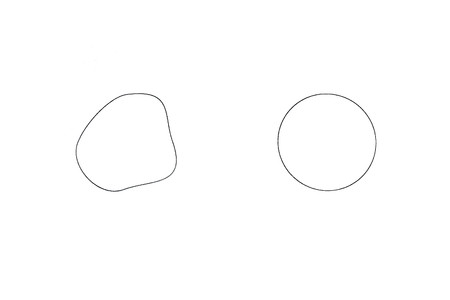
Sketch by Sebastian Gerbert
You mentioned something really interesting earlier, bringing in younger talent with a long-term perspective. It sounds like an important part of your studio’s development. Do you see this as a form of succession planning?
I would love for the company to live on beyond us. When I spent my time in Italy at Fabrica, where young designers under 25 could come together on scholarships, learn, collaborate, it was a creative hub. I think it would be great if our studio could be something more than just a business. A place where people feel safe, respected, and free to create. It’s fascinating to look at Japan, where some companies have been around for over a thousand years, even small family-run businesses. It would be amazing if we could build something with longevity, on a small scale, not a corporate level. It’s strange how design studios often seem to have an expiration date. People assume they’ll only last as long as the founding partners. But why should that be the case? Studios can evolve, renew themselves, and adapt to the times. Look at heritage fashion brands, you’re from France, so you know how some of them started with craftsmanship, like making accessories for horses, and then slowly transitioned into high fashion over decades. These brands remain relevant because they stand for something. I wonder if a design studio could function similarly, becoming a brand in itself, known for a distinct point of view. If people want to engage with that perspective, they come to us.
SG
I completely agree. A studio isn’t a static entity, it’s a living thing. The problems change, the objectives shift, and new people bring in fresh perspectives. And personally, I’m eager to learn from younger people. It helps me stay relevant. That’s why I believe the studio could, and should, keep going, even after we’re gone.
Have you ever been approached by investors? Have you considered that path?
Yes, we have been approached, but we decided to stay independent.
Work by Colors And The Kids - Nike × Lego
That’s really interesting. Even when transitioning leadership to another independent person, there are ways to put protection rules in place to ensure the structure remains independent.
In our case, it was more about someone wanting to buy us outright. Even though we would have remained involved, we built this studio to make our own decisions. Independence has always been a core value for us. The whole reason we started the studio was for freedom, and real freedom means independence. Once you join a larger group, you’re no longer truly independent, you have to report numbers, follow strategic decisions, and meet investor expectations. No one gives you money just for fun; investors want a return. Luckily, we’re in a position where we don’t need that. Just yesterday, we turned down a big-budget project that would have lasted a long time. It’s not always easy to say no, but we have the freedom to do so.
Since you’re independent, you and the other partners have to handle business development yourselves. How do you manage that?
Until now, most of our work has come through word of mouth. But since this is the largest the studio has ever been, we wanted to be more intentional about getting the kind of projects we really want. So, we recently started to work with someone for business growth.
Work by Colors And The Kids - Nike × Lego
That’s a strategic move, which is rare for independent studios. What made you feel like this was the right time to bring in a business developer?
Honestly, it’s just about being proactive. We already get a lot of great requests, and we’re in a good place, but staying independent means you can’t get complacent. There are always hungry competitors in the market, and we don’t want to take anything for granted. Even if this hire doesn’t immediately bring results, we’ve now established a process. Ultimately, it gives us more freedom to say no. We already turn down a lot of work, but having somebody on board for growth means we can be even more selective.
Speaking of saying no, do you participate in pitches or competitions?
We used to be completely against them. But the industry has changed, and now brands expect it so we’ve had to adapt. That said, because we’re in a strong position, we can still be selective. If we choose to pitch, it’s because we see value in it, whether it’s an exciting project, a great opportunity, or simply a chance to learn something new.
MB
But we still avoid free pitching whenever possible. The creative industry has a real problem with companies expecting free ideas. Instead, we do something like we did last year, when Nike and LEGO reached out, we asked if they had something specific in mind, then prepared a tailored reel for them. That way, we’re engaging without giving away fully developed ideas for free.
Work by Colors And The Kids - Nike × Lego
On a technical level, how do you structure your presentations, especially in the first round? Do you follow a set format?
Yes, we have a structured deck with consistent design principles. We also tweak small details, like changing color gradients for each round, to keep things fresh. We recently started curating our presentations more carefully. Last year, our team created so much great work for a project that we ended up with a 200-slide deck. That was just too much, both for us and the client. Now, we build more time into the schedule to refine and focus our presentations. It saves everyone time and makes our ideas more impactful.
SG
It’s also about how we’ve evolved over time. We started as a studio focused on exploration, and we still do a lot of that. Whenever we take on a new project, we explore it from every angle, trying to find the best possible approach. Now, we’ve reached a point where we also see ourselves as consultants to our clients. It’s not just about delivering the work, it’s about guiding them towards the best solution. We take a more strategic approach, challenging initial ideas when necessary. Going back to our presentations, we now structure them to include more conceptual direction for our clients, helping them see the bigger picture.
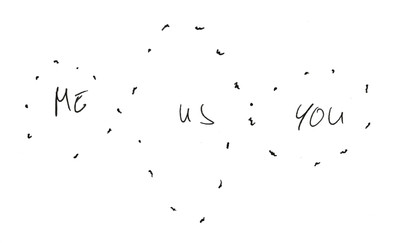
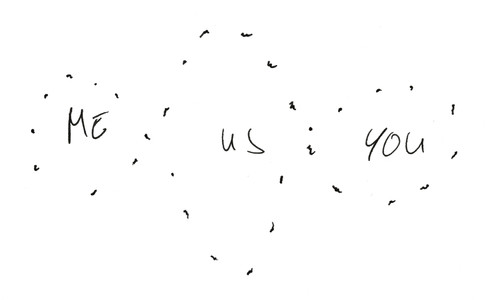
Sketch by Maik Bluhm
You mentioned earlier that some of you had kids, and that slowed down your ability to grow the studio as fast as you wanted. I think that’s an important point. Could you tell us more about that?
On a personal level, we reached a stage where the studio really needed a few more people to handle multiple projects at once. Up until then, we were managing one large production at a time, but it would have been great to scale up and take on two or more simultaneously. However, at that time, some of us were starting families, and we made a conscious decision not to expand too quickly. We had to turn down some incredible projects, which, of course, influenced our studio’s growth. The right projects at the right time often shape the direction a studio takes. For example, there was an early electric vehicle project that we were really excited about. They wanted to work with us, and it would have been an amazing opportunity, especially given our technical expertise. That project could have positioned us differently in the industry, but we just couldn’t take it on at the time. So, yes, our growth was a bit slower, but I don’t regret it. We’re doing well, and that’s just how business development works. You analyze different paths, weigh your options, and make the best decisions for the long term.
SG
Looking back, I’d say we’ve had three distinct growth phases. The first was when we started out and began gaining recognition. That led to opportunities with brands like Nike and other big names. But at that time, there was a real lack of talent in our industry. Back then, the 3D design field was just emerging. There were traditional 3D artists, but not many designers with a strong 3D background. So we couldn’t find the right people to help us grow and we had to pass up some opportunities. Then, we had kids, and that slowed things down again. But now, we’re in a different place, our kids are older, and we can develop the studio in the way we truly want.
MB
Back then, good 3D artists would often choose to work independently because their skills were rare and in high demand. Now, the industry has grown, talent is more accessible, and we’re able to find great people who want to work with us. That has led to more organic growth. Our studio has become a knowledge-sharing environment, which attracts even more talented individuals.
SG
That’s also a big part of why we stayed independent. Yes, we need to make a living, but we also want people to work here because they genuinely enjoy what they do—not just because they’re getting paid. We want our team to have as much fun creating as we do. This shouldn’t just feel like a job; it should be something they’re passionate about.
Some CGI studios struggle with high turnover, making recruitment a constant challenge. How do you maintain a strong company culture?
That’s an interesting point. We don’t actively recruit, we get applications organically. We’ve never needed to post job openings or make big announcements about hiring. For us, growth happens behind the scenes. Right now, we have 14 people in the studio, and everyone came to us because they wanted to be part of what we’re building. We review every portfolio carefully, and if someone stands out, we bring them in. Since last year, with AI advancing, we’ve been getting even more applications, sometimes two or three a day. But we’re very selective. We want people who not only have the right skills but also fit in with our team for the long term. Our first hire is still with us. I think that says a lot about how we build our team.
Having a tight-knit structure where everybody can trust each other is really the solution to creating problem-solving. We do so much behind the scenes, only a small percentage of what we do is actually shown. There are a lot of projects we can’t share. People wonder how we manage to do all we do in that amount of time, and I think it just comes down to people feeling safe in their environment, knowing they’re not going to be fired tomorrow just because another job isn’t coming in. That makes a huge difference. So we actively take those moments of calm and quietness to reassure the team. We tell them, “Let’s create cool stuff now. The next project is on the horizon.” Because we don’t just do this for profit. It’s kind of like an organism, it has its own rhythm and needs.
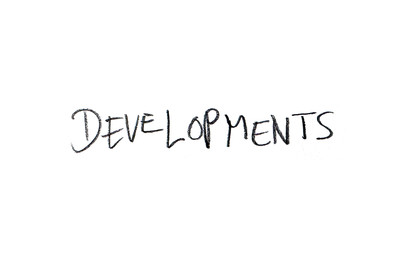
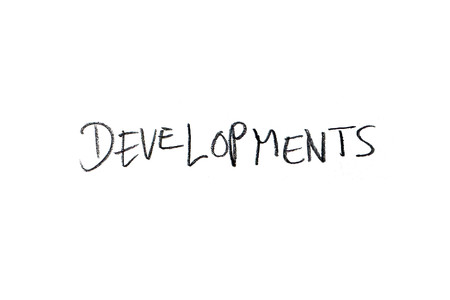
Sketch by Sebastian Gerbert
You’re 14 people now, but for a long time, you were just four. How did you learn to manage people?
Personally, I learned a lot the hard way. We founded the studio in 2008 during the financial crisis. We had no clients, no jobs. No one was interested in the stuff we were doing because we were pretty forward-thinking with 3D. So, we had to jump through a lot of hoops to get to where we are now. Also, as Maik mentioned before, we did freelance work for other companies, and we saw how people were managed there. I think we learned a lot from experience. Maybe Maik can add to this as well, our parents were all self-employed, so we grew up knowing what it’s like to run something. My father was a veterinarian. After the wall came down, he started his own practice, and I worked with him every day after school. And that probably had a huge influence on how I approach things.
MB
My father founded his shop when I was 14, and I was basically his secretary. I handled all the estimates and invoices. The deal was, he got me a computer, and I ran his office in the afternoons. And of course, you learn stuff, about invoicing, about business. When it comes to managing people, I always try to treat people how I want to be treated. We talk a lot about how the system functions, how communication works within the team. Just this week, we told everyone to share what they are working on in the daily thread so that everyone knows what’s going on, and maybe there are opportunities for help or collaboration. I think communication, transparency, respect and trust are really important.
Work by Colors And The Kids - Trafo
Do you have an ideal studio size? Or do you think 14 is the limit?
Probably one or two more. Maybe up to 20.
SG
But then I think it gets complicated. Other problems arise.
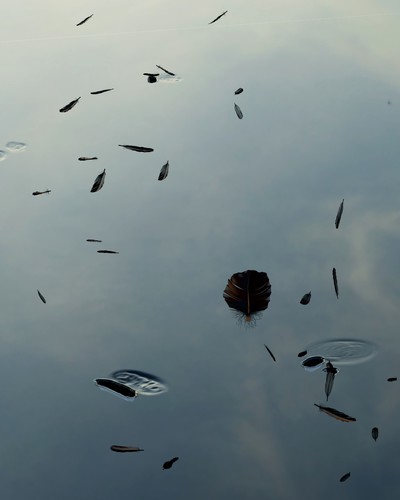

Work by Colors And The Kids - Trafo
People say that above 12, you need another layer of management, and it becomes more complicated. Are you seeing that?
Yeah, it’s definitely more. But since we’re four, we divide things among ourselves to manage the projects better. Something I didn’t realize before is how much energy it takes, not just managing people, but carrying a piece of each of them with you. Everyone has something going on, and as a leader, you deal with that mentally. When the team went over 12, I really felt it, it became more exhausting. But we’re adapting. We’re giving more responsibility to some of the team members so they manage themselves better and help each other more. That also improves quality control.
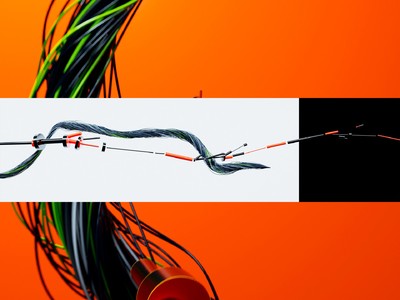
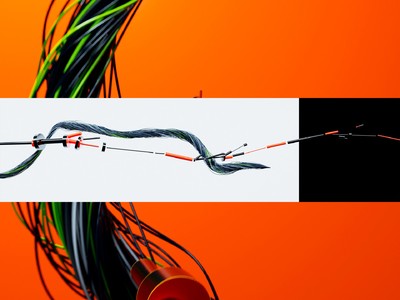
How do you handle strategic decisions like your communication on Instagram? Is it a decision made by all four partners?
I write a lot, and then I get input. I send them texts, and then Sebastian is editing them. Elisabeth writes and gives input. Ines is giving input. Then we change it. We’re each other’s editors, and I think that helps a lot.
There’s no public “incarnation” of the studio. I assume that’s a conscious decision?
That was a deliberate decision from the beginning. We wanted it to be about CATK. It’s a living entity of its own. It’s not just Maik, or me, or Ines, or Elisabeth, or the four of us.
MB
In the beginning, it wasn’t a firm decision, but then we saw people reacting like, “Oh, wait, you’re just that many people? Your output looks like this? Who are you?” We liked that mystery and made it a conscious decision to share selectively. When you put yourself out there, it has to be in the right place. You don’t just want to be in any magazine. It needs to feel right, and that’s the most important thing.
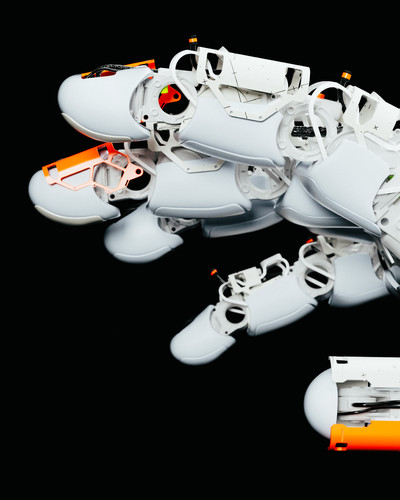
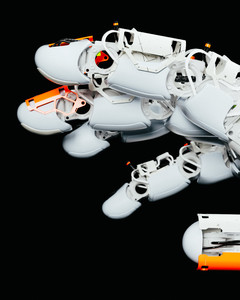
Work by Colors And The Kids - Fussel
You started in 2008, the year of the economic crisis in September. Now, we’re going through another one, quieter but potentially stronger. How would you describe both the economic and creative markets?
Right now, some companies are thriving, while others are struggling. In the creative industry, you have major players, the big seven companies like Apple, Microsoft. They’re still in a good place but competition is increasing. I don’t see it as severe as 2008, even though, from a broader market perspective, looking at the stock market or global politics, there are definitely risks on the horizon. But things are more diverse now. Luckily for us, we don’t feel the impact too much. We’ve noticed some economic shifts, but we still get plenty of requests, and things are working out.
MB
The goal is to be more like vinyl than CDs, something that lasts. There are ups and downs, but it stays. The market will always change, and now with AI, you can see it shifting. A lot of people will probably lose their jobs because of it. For example, one of our employees recently posted about a new InDesign feature that lets you copy a design from a card. When I saw that, I thought about the small neighborhood design shops, the ones making café logos or local posters. Not to sound snobbish, but AI is likely to filter out a lot of lower-end design work. You already see AI-generated, low-quality images on posters all over cities. The key is to maintain a human touch, a texture, something unique. That’s what will keep us in demand through all these changes.
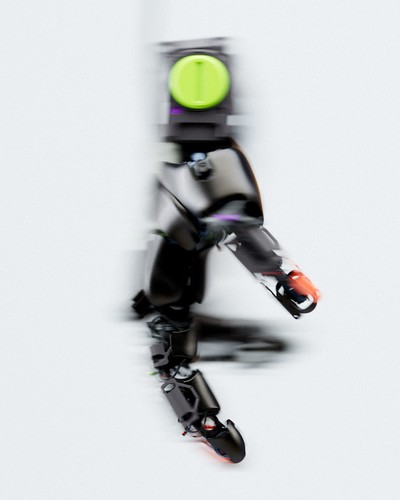
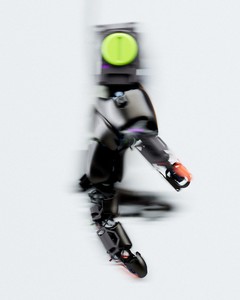
Work by Colors And The Kids - Fussel
Knowing when the right moment is for an idea, recognizing the right context. We teach this, too: The era of just making clean and nice images is coming to an end. If you want to stand out, it’ll be more about ideas, copywriting, and clever conceptual thinking.
Yes, but the problem is… a lot of people are uninformed. It sounds harsh, but you see it everywhere, in how people treat each other and even in politics. When leadership lacks taste, it trickles down into everything. After World War II, Germany suffered a massive brain drain; many leading designers, architects, and musicians fled, and while the country rebuilt a strong design culture, think Braun and the Ulm School, it never fully regained its pre-war avant-garde leadership. By contrast, countries like the Netherlands made design a national priority, with figures like Wim Crouwel shaping a cohesive visual culture through government-backed initiatives. Leadership decisions like these have a lasting cultural impact.
SG
After World War II and the split of the countries, Germany lost all its craftsmanship and experienced a brain drain, as Maik mentioned. Even in East Germany, where we come from, almost everything related to craftsmanship disappeared or was restructured into cooperatives. If you go to the countryside in France, you’ll find a nice butcher making sausages or a craft cheese shop, but in East Germany, there’s not much of that left or wasn’t there to begin with. In some areas things are starting to pick up a bit now because young people are getting interested in craftsmanship again.
So, you were raised in East Germany during the 80s?
Yes, it was a big part of who we and the studio are. We have an East German soul because we were born there. We didn’t get bananas, we didn’t get fruit juices, and all that. There was always a limitation to things. But the reunification came at the perfect moment for us because we were just starting to open up.
SG
We were becoming teenagers, and all the rules changed. Our parents were preoccupied with the political changes, their work, and how things would evolve. We were pretty much left to ourselves to experience the world, figure out our limitations, and define our boundaries. For me, looking back, it was quite interesting and had a huge influence on how I deal with things now.
MB
The 90s were such a great time.


Work by Colors And The Kids - Basketball
Now, let’s finish with some more trivial questions. Here’s the usual one: if you could do another job in another period of history, what would it be?
I’d say I’d love to have been an astronomer or an archaeologist, especially in the early 1900s, when big discoveries still were being made. Today, I’d go with gardener, it is very satisfying watch things grow.
SG
For me, it’s not so much about the time period. I would love to have been a carpenter. That would be another thing. I love working with wood and building stuff. Nature is also something I connect with, so it’s a combination of things for me.


Work by Colors And The Kids - Basketball
Are there any books that have helped you, or that you would recommend?
Over the past few years, I’ve read a lot of self-improvement books, like The Four Hour Work Week and books on how to sleep better. I’ve read, or at least listened to, a lot of those. But recently, I’ve been going back to just reading literature, like immersive stories. I think this might also be because my kids are older now, and I have more time for this kind of reading. But I really enjoy general reading and literature these days.
MB
I think one of the biggest eye-openers for me was discovering a book by Edward R. Tufte in my early 20s. It explored how data can be represented visually, and one example even touched on music, which I loved. That idea sparked my fascination with generative design. I was also deeply intrigued by synesthesia, the way music can be translated into visuals. Tufte’s book featured historical dance notation, mapping choreography with dots on the floor to show movement. It was incredible to see how many people had already been thinking about these concepts. Finding a book like that in a library is always so inspiring.
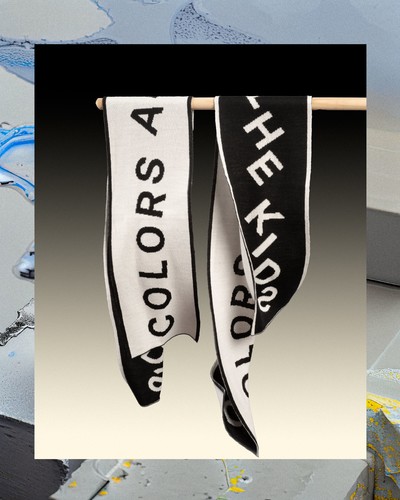
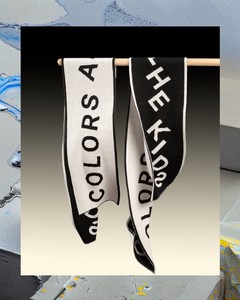
Goods by Work by Colors And The Kids
Is there an artist or a person who’s influenced your development in a similar way?
When I was in London in my early 20s, I went to the Tate Modern, and it was the first time I’d seen such a vast collection of art all in one place. From big installations to Gerhard Richter’s work, to modern art like Cubism, it was a true revelation. I’ll always remember that moment. It left a lasting impression on me.
SG
For me, it’s a bit similar. I don’t come from a family where art is a part of daily life, and I experienced art later in life. When I started studying, I got into art and began visiting places like Tate Modern, going to big museums, and seeing all the classic artworks that had a huge impact on me. I also studied at the Bauhaus in Weimar, and their history really influenced me. For example, Oskar Fischinger’s moving paintings sparked my interest in animation. I was fascinated by how they used just 12 frames to create abstract art, which inspired me to translate that into a digital form. This experimentation with color and rhythm, especially when combined with music, felt like a precursor to modern music videos or visual music. It left a lasting impression on me.
MB
What came to my mind was 1995, when Christo and Jeanne-Claude wrapped the German Reichstag. I thought that was mind-blowing because I had never seen anything like it. To think someone could wrap an entire building with fabric, such a bold, unusual idea, was incredible. That was one of those pieces of public art that became a huge topic in the news. I really like public art because it allows people to experience it firsthand, even if they don’t have any deep knowledge of it. They can just walk through and see something wild happening, which is exciting.
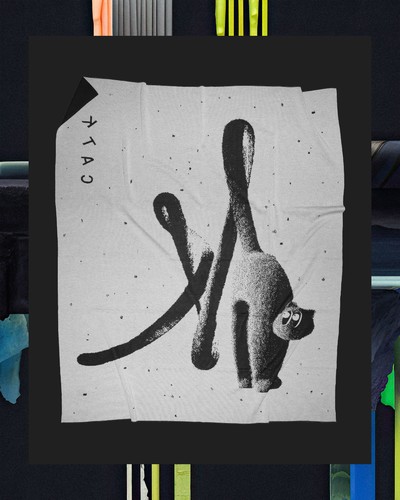
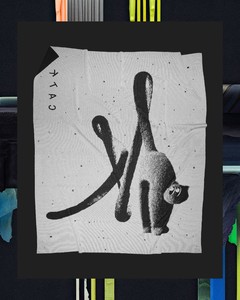
Goods by Work by Colors And The Kids
If you had to give one piece of advice to a young creative designer starting out today, what would it be?
Don’t spend too much time on social media. Trust your instincts and be yourself. I know it’s something everyone says, but it’s really true. There’s only one you, and the others are already out there, so just focus on your version and be nice to others.
SG
It sounds a bit cheesy, but being curious is key. That’s the foundation of our studio, our name, “Colors and the Kids,” comes from the idea that kids see the world without prejudice. They just experience things for the first time. Maintaining that mindset as you grow older helps you stay relevant, creative, and adaptable.
MB
Off the record, though, it’s hard. Life moves so fast these days, and with all the social media, it’s crazy. Young people do something, and then they get judged by it, whether through likes or comments. I can’t imagine how it would’ve affected us if we’d grown up in that environment. That’s why I think it’s better for young people to stay off that stuff until they’re more secure in themselves. I even think our kid shouldn’t get a smartphone until she’s 18. It’s something we’re already talking about, even though she might feel a little left out. From everything I’ve read, it’s clear that it’s not good for their mental health.
Have you seen the recent MIT research about people interacting a lot with AI chatbots?
Yes, the research shows how people start developing feelings of loneliness when they interact too much with chatbots and their intellect goes down.
I’ve started using Grammarly again lately because it focuses more on spelling rather than changing things too much, and it gives you better control over what to edit. It’s crazy, life moves so fast, and now you can paste something into ChatGPT, get a correction, but sometimes it either misses things or changes them completely. It’s not always accurate. That’s a huge problem because so many young people rely on it without questioning it. I read a study suggesting that using AI tools like ChatGPT can affect how young people think analytically, changing how they process and understand information, especially with longer texts.
SG
That’s true. It’s like reading a summary of a book instead of reading the book itself. You miss out on the depth of it. Another thing is that everyone’s living in their own little bubble now. They’re getting tailored information from chatbots or social media, and everything’s targeted just for them. It’s dangerous because, in the end, the chatbot tells everyone the same thing and just feeds them what they want to hear. It creates this false sense of connection, but in reality, everyone’s just sitting there feeling lonely.
MB
I think this will probably be one of our biggest challenges moving forward. Major clients are starting to use AI, even low-quality AI, just because the hype is so big that they feel they have to use it to avoid missing out.
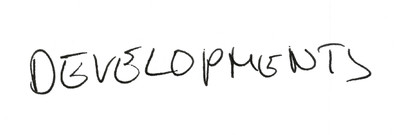
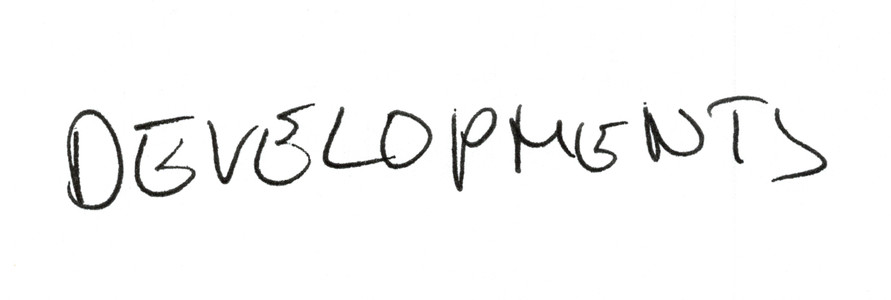
Sketch by Maik Bluhm
